
IRIS login | Reed College home Volume 92, No. 2: June 2013
Going through the Fire (continued)
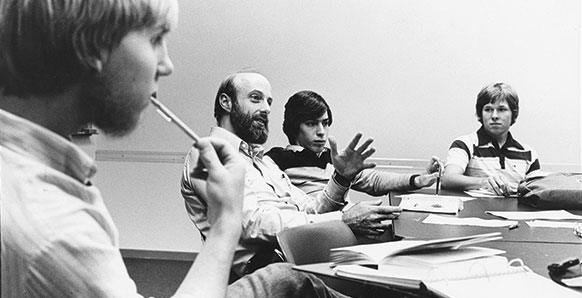
Robert Knapp: “Every argument can be challenged.”
“As a rough working rule,” mused Dexter Keezer [president 1934–42], “I thought a college ought to be willing to accommodate about 5% of freaks and geniuses in its student body, and not be too much bothered by what they did or why they did it. At Reed it seemed to me that that 5% joint classification was exceeded.”
Reed’s high tolerance for individualism—for allowing people to be themselves without the fear of being judged as different, strange, or eccentric—distinguished the community from its very beginning. The archetypal story found in the oral histories is one of having grown up feeling out of place or misunderstood among family and community, and then arriving at Reed with a sense of having come home.
“I immediately realized—almost in a blinding flash of epiphany—that this was where I personally belonged,” said Rhodes Scholar Gale Dick ’50. “For the first time in my life I was with a whole bunch of people who shared all kinds of interests. Until then I didn’t know that there was anybody else in the world who did.”
Coupled with this sense of camaraderie was another common Reed archetype—that of the big frog arriving from the small pond. “I had never met anybody smarter than I was when I was growing up,” said Joe Weisman ’65. “I got to Reed and all of a sudden I was just kind of middle, or less.”
This humbling adjustment in personal narrative was critical to William Foster’s use of rigor. Arguably, the most transformative learning systems are inherently authoritarian—they seek first to make you vulnerable by highlighting your ignorance, and then they dominate you. Their ability to leave a lasting imprint rests in great part on your surrendering to their dominance. At Reed, some students found the experience liberating.
“The first two years of the Reed system, that of knocking the arrogance out of you, really worked for me,” Mertie Hansen Mueller ’56 said. “I went from thinking I was the smartest, strongest person to being completely open to learning because I knew that there was so much I didn’t know, that I would never know, no matter if I studied a lifetime.”
Other students, including many used to being recognized and rewarded as high achievers, found that this shift to lifelong learning gave rise to a sense of “impostor’s syndrome.”
“Many of my advisees were certain that they had been admitted by error,” said professor Carol Creedon [psychology 1957–91]. “Since entering Reed they had become more convinced than ever that they were unworthy, and that the mistake would be discovered at any moment. I told them that they were far from unique, that in fact the Reed norm was very close to where they were.”
What became evident to even the brightest students was that a high IQ or perfect GPA score in high school wasn’t enough to guarantee success at Reed. It also took grit and perseverance.
“All of my friends from Lincoln High School in Portland who had started with me dropped out one by one,” said Helen Thorsen ’24. “If you didn’t make study your whole life, you might just as well not even try, because if you tried to do anything else, you were sunk.”
Adding to the workload stress was a chronic sense of dissatisfaction many students felt about the papers they wrote or the research they conducted, some of it exacerbated by the college’s policy of providing narrative evaluations of the students’ work instead of reporting their grades to them.
“If you weren’t doing well, you would get a white slip in your mail slot,” said Carl Larson ’27. “The first time I got a warning, I thought I had been at the top of the class. I corralled that professor right away. He said to me, ‘Oh, you can do better.’ To which I responded, ‘If you’re already doing the best you can, how are you going to do any better?’ He said, ‘Just keep showing up.’”
The expectation of continual improvement, exacerbated by curricular hurdles like the junior qualification exam and senior thesis, pushed most students beyond their intellectual comfort zones.
“The junior qual for political science majors lasted a whole week,” said Elizabeth Tabor Mullady ’38. “There were no subjects. They could ask you about anything. You could go anyplace to take it, even off campus. Do anything you wanted to do. Take any books you wanted to read. Nothing would help. If you had asked me my name at the end of it, I couldn’t have told you. I was just gone.”
The effect was partly intentional. If, on some level, we know what the learning system wants from us—say, by the use of grades as feedback on a defined path toward earning a degree to enter a specific career—we can erect certain internal defenses that allow us to choose how much of ourselves we give away to the system. But when the contract with the system is as existential as learning for the sake of learning, and progress is measured more qualitatively than quantitatively, we are apt to lose some of our psychic protections, allowing the system to get more deeply into our heads. This, arguably, was the true agenda of William Foster’s plan.
Reed found its ideal vehicle for this intellectual immersion in the college’s groundbreaking humanities program. Developed in 1921 by Foster’s successor, Richard Scholz [president 1921–24], the mandatory one-year freshman course (originally offered until 1943 in two sequential tracks of history and literature) was both an innovation and an outlier in higher education. No mere civics course or history of Western society’s early development in Greece and Rome—as was the case with many of the Western civilization courses that followed it in the 1920s and 1930s—humanities as taught at Reed was first and foremost a pragmatic training ground. Students learned critical thinking by doing critical thinking. They did so in small conferences patterned after those Richard Scholz had experienced at Oxford as a member of the first class of American Rhodes Scholars in 1904.
“Freshman humanities was the thing that changed most of us,” said Armand Schwartz ’60. “The course just knocked the pins out of everybody, and we had to rethink who we were, what we were, and where we were going and why. The purpose of the whole exercise seemed to be to take you apart, examine everything, and then put you back together. It was just like rebuilding an engine.”
Professor Rex Arragon [history 1923–62], who directed Reed’s humanities program for more than 40 years, claimed that he followed John Dewey’s maxim of “learning by doing”—the “doing” in this case being reasoning.
“According to Dewey,” Arragon said, “a situation does not simply mold us, we also shape it by our scientific inquiry. We use our heads, that is, our reason. We observe systematically, inquire, and experiment by formal procedures, then distinguish, analyze, relate ideas, and draw conclusions. Rationality is essential. Without it, instrumentalism, like other empiricism, is helpless. Emphasis upon reason, upon critical intelligence or cautious thinking, is the chief means as well as one of the significant ends of study.”
To instigate this kind of critical thinking in the small humanities conferences, professors employed the Socratic method. “You always answered a question with a question,” said professor John Pock [sociology 1955–98]. “The demand was very heavy on the students to do the discovery of the issues, and to analyze and examine a line of argument. It wasn’t a matter of the teacher sitting there and doing a minilecture on something.”
This approach relied upon a pedagogy of what might be called “informal reasoning.” According to studies in cognitive science, engaging students in such a manner makes reasoning more deliberate, transparent, and step oriented than displays of formal reasoning—the professorial “sage on the stage,” or what William Foster derided as “assembly-line and loudspeaker education”—where a professor pours information into the minds of students with hopes of making them wise. Relying too heavily on formal reasoning—the so-called “expert’s blind spot” where content knowledge tends to eclipse pedagogical knowledge—provides students with little insight into how to solve real problems, because they do not gain access to the professor’s own cognitive “box of tricks.”
“Reed teachers did not pontificate,” William Foster maintained, “they guided. And they did not always win arguments with students.”
But they did set the standards of reasoning.
“You had a problem that you asked students to pursue,” said longtime professor Marvin Levich [philosophy 1953–94], “and then you talked at it as if everyone in that class were a professional, as though they were your equals. That was a method of teaching that made some people uncomfortable, but in a lot of cases it was amazing how—if you expected the best from the students—how many of them would, in one way or another, fulfill your expectation. I thought that any other method of teaching was coddling the students.”
This modus operandi was essential to Foster’s idea of a democratic learning environment where students engaged with teachers as “coworkers” in constructing knowledge, not merely consuming it. That required placing more emphasis on encouraging the characteristics involved in forming a flexibility of perspective—motivation, curiosity, imagination, and creativity—than merely learning by rote and recall. The approach was institutionalized in the mandatory humanities course, whose broad coverage of literature, history, philosophy, religion, politics, and the arts meant that no professor could possibly be an expert in every discipline.
“That leveled the playing field,” said professor Robert Knapp [English 1974–], “so that both faculty and students were in the position of having to confront and make sensible arguments about things that ought to be part of the common heritage—whether or not they really are—and to do so on a basis where every argument can be challenged, where nobody can just pull out the particular expertise to say, ‘Well, I just happen to know the answers to more of these things.’”
This combination of amateurism and professionalism—the professionalism for faculty having to do with how to address a field of study, what kinds of question to ask, what kinds of answers make sense—was essential to the success of teaching humanities at Reed.
“We had guys who were more brilliant than the professors,” said Abe Bergman ’54, “but they flunked out. The fact that the professors knew you and you couldn’t BS, that alone was a discipline in critical thinking, of learning to speak your mind, of learning to question everything. ‘What do you mean?’ ‘Why do you say that?’ ‘What’s your evidence for that?’ Those kinds of questions were constantly facing you, and you had to answer them.”
The questions did not end at the conference door. They continued in the dormitories, the coffee shop, the dining hall, the sports center, and out on the quad. The level of discourse could be just as rigorous as in the classroom. Many alumni claimed in their oral history interviews to having learned as much from their fellow students as from their professors.
“We played cards for keeps, we discussed things for keeps,” said Richard Abel ’48. “It was almost literally blood on the floor at the end of the night if you didn’t pay attention.”
Indeed, the intensity of Reed’s rigor took its toll. After the first two graduating classes in 1915 and 1916, Reed’s student retention rate dropped to between 40% and 50%, and remained there for the next 50 years. This created a bruising system of culling students after admittance, who, for various reasons, did not find Reed suitable, and either transferred to other schools or dropped out. For some alumni who experienced those early sink-or-swim decades, the low graduation rate represented a badge of perseverance and endurance. For others, both graduates and nongraduates, it left them with a love-hate relationship with the institution.
With its five-year graduation rate now at 80%, Reed has in recent decades become a kinder and more supportive institution, with expanded counseling, wellness programs, cultural events, and academic support services. These changes, however, have not eliminated the creative tension and stress generated by the intensity of the academic program. Students still complain of Reed’s “stress culture.” That may be the inevitable nature of any truly transformational experience—it’s supposed to be hard.
In today’s globalized world, where students are exposed to ever-increasing levels of complexity and rapidly shifting mental frameworks, “perspective is more valuable than IQ,” asserts Nicholas Negroponte, founder of MIT’s innovative Media Lab. Yet, the dominant educational models remain heavily weighted toward the instrumental purpose of cultivating knowledge for the sake of doing. In addition, higher education is now faced with the emergence of the Massive Open Online Course (MOOC), a digital version of the “assembly-line and loudspeaker” model of yesteryear that, with its promises of greater efficiency and broader democratization of education, threatens the relevancy of the liberal arts.
Faced with a similar situation 100 years ago, William Foster sought to address the challenge with a new model that trained students to become innovative thinkers in the worlds they entered after graduation. By merging the Greek idea of knowledge for the sake of being with the pragmatists’ approach to critical thinking, he designed a transformational learning system capable of leaving students with an indelible mark of self-knowledge, one that allowed them to hold their ground and constructively challenge the status quo, no matter what career they pursued. The promise of that outcome continues to attract a certain type of student to Reed today.
“When Dean of the Faculty Peter Steinberger [political science 1977–] proclaimed at my senior dinner that Reed College was the best liberal arts college in the country,” said Gabe Gao ’09, “I rolled my eyes, and let out a dismissive puff of air from between my pursed lips. Even in the throes of thesis parade and Renn Fayre jubilation, I had very ambivalent feelings about having attended Reed for the past four years. Yet, within six months of graduating, I could not help but fully agree with Steinberger. This sentiment has nothing to do with comparing Reed to other colleges. Rather, it is a deep, inner feeling that those four years were well spent, and that my experience at Reed College has enabled me to become the kind of person that I actually want to become.”
GO FURTHER
Comrades of the Quest: An Oral History of Reed College. Oregon State University Press, 2012.
- Previous Page
- 1
- 2
- Next Page
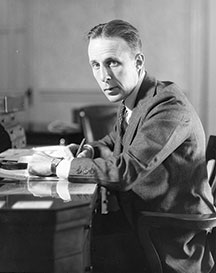
![Prof. Carol Creedon [psych 1957-91] said many students “were certain they had been admitted by error.”](../images/277_CreedonCarol1978.1.jpg)
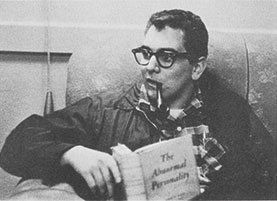
![Prof. Rex Arragon [history 1923–74] was the intellectual architect of freshman Humanities.](../images/277_RexArragon.jpg)
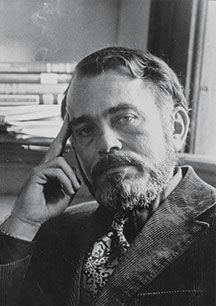
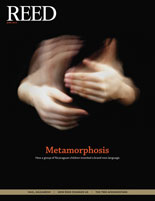
LATEST COMMENTS
steve-jobs-1976 I knew Steve Jobs when he was on the second floor of Quincy. (Fall...
Utnapishtim - 2 weeks ago
Prof. Mason Drukman [political science 1964–70] This is gold, pure gold. God bless, Prof. Drukman.
puredog - 1 month ago
virginia-davis-1965 Such a good friend & compatriot in the day of Satyricon...
czarchasm - 4 months ago
John Peara Baba 1990 John died of a broken heart from losing his mom and then his...
kodachrome - 7 months ago
Carol Sawyer 1962 Who wrote this obit? I'm writing something about Carol Sawyer...
MsLaurie Pepper - 8 months ago
William W. Wissman MAT 1969 ...and THREE sisters. Sabra, the oldest, Mary, the middle, and...
riclf - 10 months ago